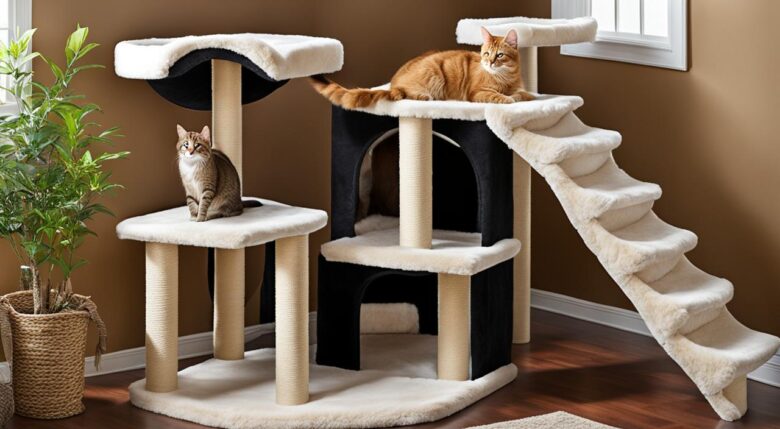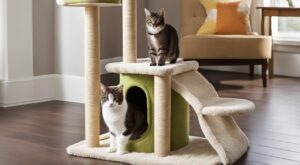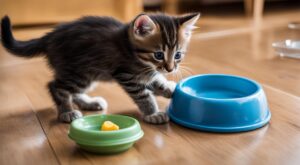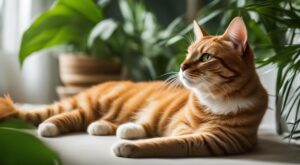As cat owners, we know how important it is to keep our feline friends happy, healthy, and entertained. Providing them with a dedicated space for play, exercise, and relaxation is essential, and cat trees are the perfect solution.
Cat trees come in various shapes and sizes, from simple scratching posts to multi-level cat condos with intricate designs. But with so many options available, it can be overwhelming to choose the right one.
In this comprehensive guide, we’ll explore the different types of cat trees and their unique features, discuss the benefits of providing a dedicated space for climbing and scratching, and share tips on maintaining and cleaning your cat tree.
Key Takeaways
- Cat trees are an essential part of a happy and healthy feline lifestyle.
- There are various types of cat trees available, from simple scratching posts to multi-level cat condos with intricate designs.
- When choosing a cat tree, consider your cat’s size, age, and preferences.
- Maintaining and cleaning your cat tree regularly is important for its longevity and hygiene.
- Introduce your cat to their new tree slowly and encourage positive associations.
The Importance of Cat Trees for Your Feline Companion
As a responsible cat owner, it’s essential to understand the significance of cat trees in keeping your furry friend healthy and happy. Cats are natural climbers and scratchers, and by providing them with a dedicated space for these activities, you can help them maintain their physical and mental well-being.
A cat tree or cat furniture is not just a piece of fancy decor. It’s a functional addition to your home that can serve as a safe, fun, and comfortable space for your cat to play, relax, and rest. By offering various levels for climbing, scratching posts for grooming, and perches for napping, a cat tree can add stimulation to your cat’s life and help them fulfill their natural instincts.
Without designated cat furniture, cats may resort to using your furniture, curtains, and carpets for scratching and climbing, leading to costly damage to your home. A high-quality cat tree can save your furniture and serve as an excellent outlet for your cat’s energy and playfulness, while offering you peace of mind.
Cat trees come in various sizes, designs, and materials, so you can choose one that suits your cat’s preferences and your home decor. However, before purchasing a cat tree, it’s essential to consider your cat’s age, size, and activity levels to ensure it’s a suitable fit.
In the next section, we’ll discuss the critical factors to consider when selecting the perfect cat tree for your feline friend.
Factors to Consider When Choosing a Cat Tree
Choosing the perfect cat tree for your furry friend can be overwhelming. Here are some essential factors to consider:
Size
Consider the size of your cat and the space where you plan to place the cat tree. A larger cat tree with multiple levels may be suitable for bigger cats, but it may not work for smaller living spaces.
Material
Materials such as wood, carpet, or sisal rope can affect the durability and stability of the cat tree. Look for sturdy materials that can withstand your cat’s weight and playful behavior.
Design
The design of the cat tree can also affect its functionality and appeal to your cat. Some cats prefer vertical space, while others like horizontal areas. Consider your cat’s habits and preferences when selecting a design.
Features
Features such as scratching posts, hiding spots, and perches can contribute to your cat’s enjoyment and engagement with the cat tree. Scratching posts made of sisal rope or corrugated cardboard can be especially beneficial for satisfying your cat’s natural scratching instincts.
Remember to select a cat tree that fits your budget and your cat’s needs and preferences. A high-quality cat tree can provide your furry friend with a dedicated space to exercise, play, and relax.
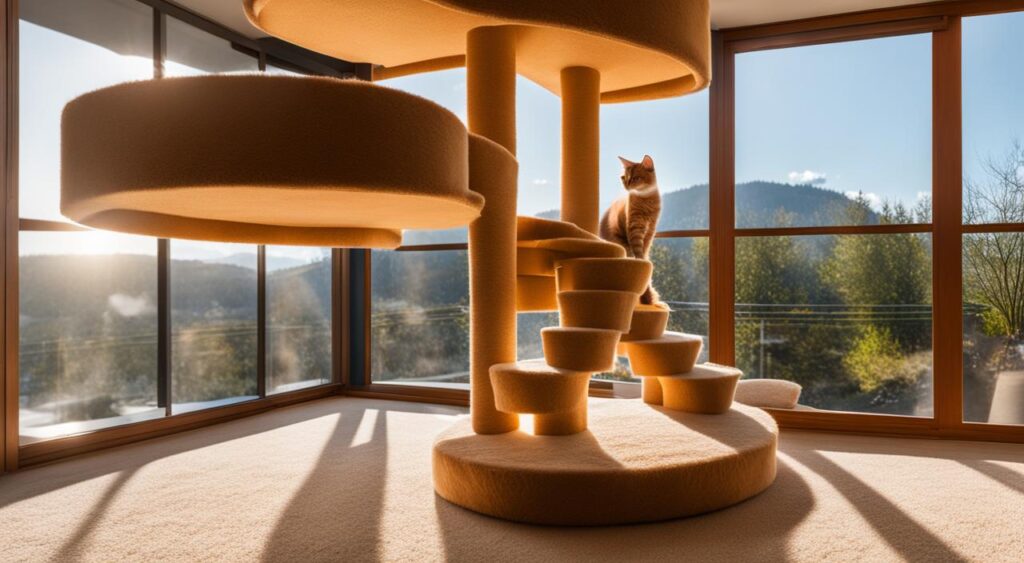
Different Types of Cat Trees and Their Features
Providing your cat with a dedicated space for play, exercise, and relaxation is crucial for their overall well-being. Cat furniture, such as cat trees, offer a variety of benefits to your feline friend, including relieving stress, preventing destructive behavior, and promoting a healthy lifestyle. In this section, we’ll explore different types of cat trees available in the market and their unique features.
Multi-Level Cat Condos
Multi-level cat condos feature various platforms and perches for your cat to climb, jump, and lounge on. They may include built-in scratching posts and hidden compartments for your cat to retreat and relax. Ideal for cats that enjoy heights and elevated areas, multi-level cat condos provide a safe and comfortable environment for your cat’s playtime.
Interactive Cat Activity Trees
Interactive cat activity trees come with a range of features to keep your cat entertained and engaged. They may include hanging toys, tunnels, and hiding spots. Some models even have built-in electronic features, such as motion sensors and sound effects. Interactive cat activity trees are perfect for playful and curious cats that enjoy exploring new environments.
Cat Perches and Shelves
Cat perches and shelves offer a versatile and space-saving solution for small apartments or homes. They can be attached to walls or windowsills and provide your cat with a bird’s eye view of their surroundings. Some models come with built-in scratching posts and hiding spots. Cat perches and shelves are perfect for cats that enjoy observing their environment and lounging in the sun.
Cat Climbing Trees
Cat climbing trees feature vertical surfaces and are suitable for cats that enjoy climbing and scratching. They may have built-in toys and scratching posts and provide your cat with an outlet to engage in their natural behaviors. Cat climbing trees come in various sizes and shapes, making them a great addition to any home.
Cat Scratching Trees
Cat scratching trees are designed specifically for cats to scratch and sharpen their claws. They may have multiple scratching surfaces, including sisal rope and carpet. Cat scratching trees come in various sizes and designs, making them a great addition to any home seeking to prevent costly furniture damage.
DIY Cat Trees: Building Your Own Feline Oasis
Building a cat tree of your own is a satisfying project that can save you money and provide your cat with a unique and personalized space to play, scratch, and rest. When considering building a cat tree, keep the following tips in mind:
- Choose high-quality materials: Look for sturdy and durable materials, such as solid wood or plywood, that can withstand the wear and tear of your cat’s activity and weight.
- Consider the design: Plan your cat tree’s design based on your cat’s size, age, and preferred activities. You can include various levels, scratching posts and pads, dangling toys, and comfortable perches for them to rest on.
- Invest in good tools: To ensure accurate cuts and safe assembly, it’s crucial to have quality tools such as a saw, drill, and staple gun.
When building your cat tree, here are some additional things to keep in mind:
- Follow the instructions or plans carefully to ensure that the completed project is stable and safe for your cat to use.
- Sand all surfaces of the wood to remove any rough edges and to prevent splintering.
- Cover the scratching surfaces with sisal rope or carpeting, securely fastened with staples or glue.
- Place the cat tree in a room where your cat frequently spends time, and where you can easily supervise their use of the tree.
Before starting your project, take a moment to view the image below for inspiration:
“Building our own cat tree was a fun and rewarding weekend project for me and my kids. Our cat loves it, and we saved some money compared to purchasing a similar model from the store!”
Maintaining and Cleaning Your Cat Tree
Keeping your feline friend’s cat tree clean and free of debris is essential to ensure its longevity and hygiene. Here are some easy tips and tricks to help you maintain and clean your cat tree:
- Regularly vacuum the cat tree to get rid of dirt and hair.
- Wipe down the cat tree with a damp cloth to remove any stains or spills.
- Use a pet-friendly disinfectant to sanitize the cat tree periodically.
- Check and tighten any loose screws or bolts to ensure the tree is stable.
- Replace worn-out scratching posts to prevent your cat from scratching the furniture or carpet.
With proper care, a high-quality cat tower or cat condo can last for years and provide your cat with a comfortable and entertaining space for play and relaxation!
Signs it’s Time to Replace Your Cat Tree
| Signs | Action to Take |
|---|---|
| The cat tree is wobbling or unstable | Inspect the structure and tighten any loose screws or bolts; replace the tree if necessary. |
| The fabric or material is torn or frayed | Replace the affected area of the tree or buy a new one. |
| The scratching posts are worn out or shredded | Replace the posts or purchase new ones to prevent your cat from scratching other household items. |
| The tree emits an unpleasant odor or has visible stains | Disinfect the tree or replace it entirely if the odor or stains persist. |
“A clean home is a happy home, and this also applies to your pet’s favorite space. Regular cleaning and maintenance of your cat scratching tree can prevent the spread of disease and prolong the life of the tree.”
Introducing Your Cat to their New Tree
Bringing home a new cat tree can be exciting for you and your furry friend. However, your cat may not know what to make of their new vertical playground at first. Here are some tips for helping your cat feel comfortable with their new cat tree:
- Place the cat tree in a prominent location in your home, such as near a window or in the living room, where your cat can see and explore it.
- Encourage your cat to approach the tree with catnip or treats to create positive associations with their new play area.
- Use toys or a laser pointer to attract your cat to the cat tree and encourage exploration.
- Provide your cat with plenty of praise, attention, and treats when they use the cat tree.
It’s important to remember that cats may take some time to adjust to their new surroundings. Be patient and give your cat time to explore their new play area at their own pace.
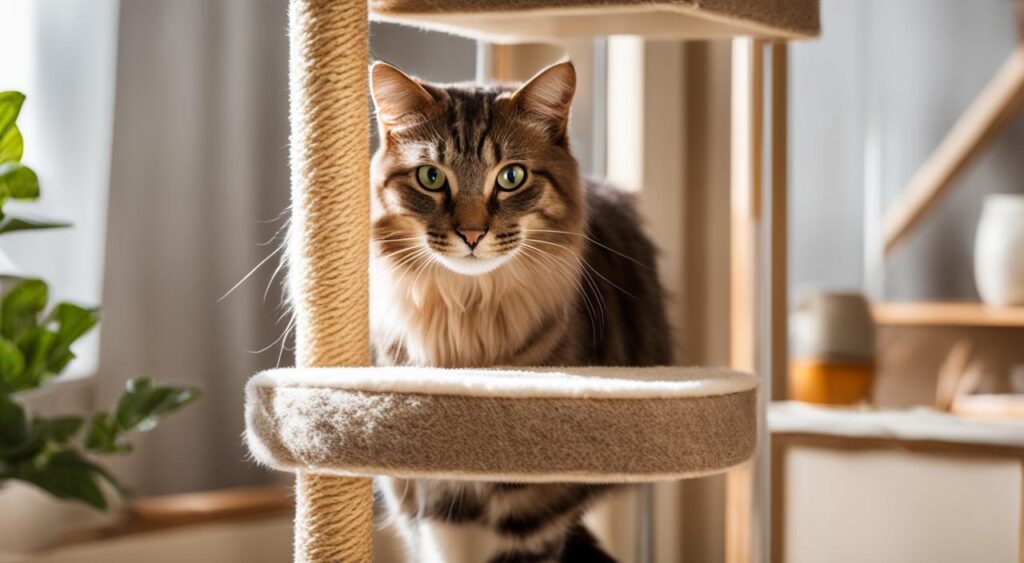
Conclusion
Investing in a high-quality cat tree is a great way to provide your feline friend with a dedicated space for play, exercise, and relaxation. With the variety of options available, it’s essential to consider your cat’s needs, preferences, and activity level when choosing the perfect cat tree. With options such as cat furniture, climbing trees, activity trees, and scratching posts, finding the right one for your furry friend is easier than ever.
Remember to keep your cat tree well-maintained and clean, replacing any worn-out components such as scratching posts or covers as needed. With proper care, your cat tree can last for many years, providing your pet with endless hours of entertainment and relaxation.
We hope this comprehensive guide has helped you understand why cat trees are essential for your cat’s overall well-being and provided valuable insights to help you choose the perfect one for your feline friend.
Invest in a cat tree today and watch your furry friend thrive in their new vertical playground!
FAQ
What is a cat tree?
A cat tree is a piece of furniture designed especially for cats, providing them with various levels, platforms, and perches to climb, play, and relax on. It typically includes features such as scratching posts, hiding spots, and toys to keep cats entertained and engaged.
Why do cats need a cat tree?
Cat trees serve several important purposes for cats. They provide a safe and elevated space for cats to observe their surroundings, which appeals to their natural instincts as tree-dwelling animals. Cat trees also offer opportunities for exercise and play, as well as a dedicated place for scratching to help keep their claws healthy and strong.
How do I choose the right cat tree?
When choosing a cat tree, consider factors such as the size of your cat, the available space in your home, the materials used in the cat tree’s construction, and the features that will best suit your cat’s preferences. It’s important to select a sturdy and stable cat tree that can safely accommodate your cat’s weight and activity level.
What are the different types of cat trees available?
There are various types of cat trees to choose from, including multi-level cat condos, cat towers, cat activity trees, and cat perches. Each type offers different features such as scratching posts, hanging toys, hammocks, and hiding spots. It’s important to select a cat tree that provides a balance of climbing, scratching, and resting opportunities based on your cat’s needs.
Can I build my own cat tree?
Yes, building your own cat tree can be a fun and rewarding DIY project. There are plenty of online resources that provide step-by-step instructions and design ideas. Just make sure to use cat-safe materials, secure all parts properly, and consider your cat’s size and preferences when designing the tree.
How do I clean and maintain my cat tree?
To clean your cat tree, regularly remove any loose fur or debris, and wipe down the surfaces with a mild detergent and warm water. Pay special attention to the scratching posts, as they can accumulate dirt and oils. If the scratching posts become worn out, consider replacing them to maintain your cat’s interest and prevent them from sharpening their claws on other furniture.
How do I introduce my cat to their new cat tree?
Introducing your cat to their new cat tree requires patience and positive reinforcement. Place treats and toys on different levels of the tree to encourage exploration. Use praise and rewards when your cat uses the tree and make sure to gradually increase their exposure to it. Allow them to get comfortable at their own pace and create positive associations with the tree.

